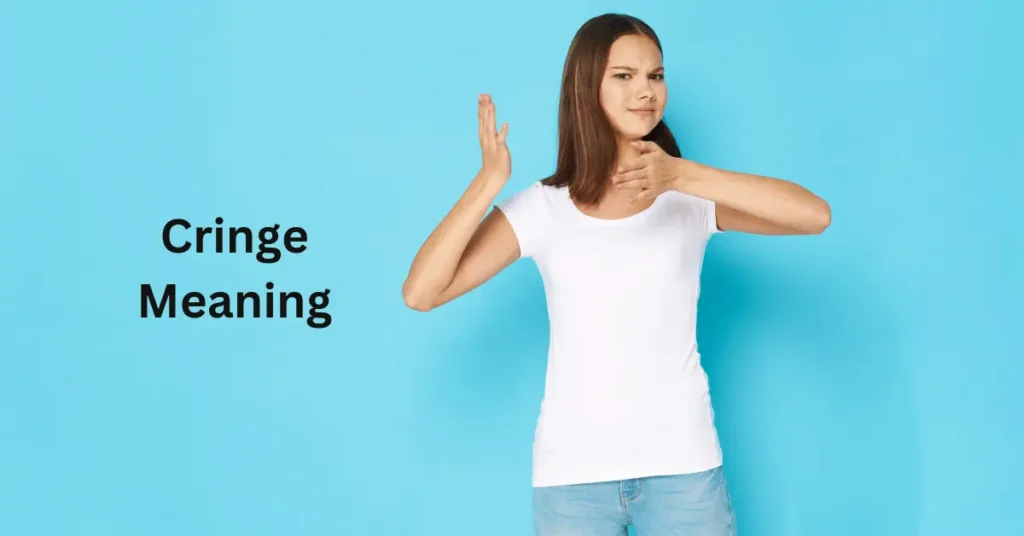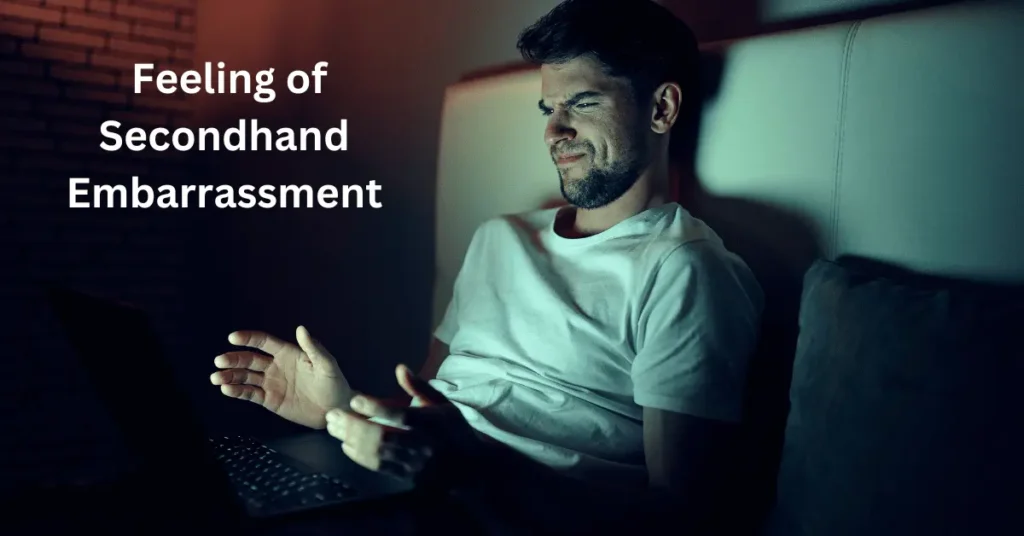Cringe Meaning

Let’s learn about cringe meaning with us. We’ve all heard the word “cringe” floating around, especially online. It’s one of those words that’s used to describe something awkward, embarrassing, or just plain uncomfortable.
But have you ever stopped to think, what is the meaning of cringe? While it might seem like just another trendy slang term, “cringe” actually has a pretty interesting history.
Whether it’s a cringe-worthy video, an awkward social situation, or something that makes you squirm in secondhand embarrassment, this word is all about those moments that make us feel uneasy.
In this article, we’re going to break down what “cringe” really means and how it became such a popular part of our everyday vocabulary!
What Does It Mean?
The word “cringe” has its roots in physical actions, but over time, it’s become a term we use to describe uncomfortable or embarrassing situations.
Originally, to “cringe” meant to physically shrink back, bend, or crouch—typically out of fear, pain, or submission. Imagine a person recoiling from something unpleasant, like when you see a scary creature or experience something painful.
That’s the old-school meaning of the word.
However, as language evolved, so did the use of the word “cringe.” Nowadays, it’s most commonly used in a figurative sense.
Instead of describing a physical reaction, Cringe now refers to the feeling of secondhand embarrassment or discomfort we get when witnessing something awkward, socially inappropriate, or overly embarrassing.
For example, if you watch a video where someone tries to perform a dance but they’re really bad at it, you might feel embarrassed for them.
That feeling is the essence of “cringe.” It’s a reaction to something that makes you want to mentally “shrink back” or look away, because it’s just so awkward or uncomfortable to witness.
It can also refer to situations where someone is being overly sincere or trying too hard, which makes the people around them feel uncomfortable.
For instance, imagine someone giving a really exaggerated, heartfelt speech at a party when it’s completely out of place.
You might hear others describe that situation as “cringe,” because the sincerity feels over the top and awkward.
To sum it up, when something is described as “cringe,” it means it causes a reaction of discomfort, whether that’s from embarrassment, awkwardness, or just plain secondhand awkwardness.
It’s that feeling when you want to cover your eyes or look away because the situation feels too awkward to handle!
Definition and Examples of What Is the Meaning of Cringe
Definition
At its core, “cringe” refers to a physical reaction where someone shrinks back, bends, or crouches, often due to fear, discomfort, or a sense of submission.
It originally described a bodily movement, like recoiling from something that causes pain or fear.
However, in modern usage, “cringe” has evolved into a term used to describe feelings of discomfort, embarrassment, or secondhand shame—usually triggered by something awkward or socially inappropriate.
When we say something is “cringe,” we’re often talking about how the situation makes us feel.
It’s that moment where you physically squirm or wish you could look away because it’s so awkward, embarrassing, or out of place.
It’s more about the emotional response to awkwardness than a literal physical reaction.
Examples
- Awkward Social Situations: Imagine you’re at a party, and someone you barely know starts talking loudly about their latest accomplishments in a way that feels boastful and uncomfortable. As they continue, you feel yourself shrinking back in discomfort. This situation might be called “cringe” because it’s causing you secondhand embarrassment. The person isn’t intentionally doing anything wrong, but their behavior feels socially awkward.
- Over-the-Top Performances: Picture a talent show where someone tries to sing a song but does so poorly—off-key and out of tune. Their enthusiasm doesn’t match their ability, and it’s so bad that the audience can’t help but cringe. You may feel embarrassed for them, even though they’re the one performing. In this case, the bad singing and the mismatch between their energy and skill level make it “cringe-worthy.”
- Trying Too Hard: In a group setting, someone might try to impress others by telling a joke they think is funny but comes across as awkward or outdated. Their attempt to be the center of attention falls flat, and everyone in the room feels a sense of discomfort. People may say, “That was so cringe,” because the joke felt forced and out of place.
- Cringe-Worthy Content Online: On the internet, you’ll often hear the term “cringe” used to describe videos, memes, or trends that evoke secondhand embarrassment. For example, someone might post a video of themselves doing something embarrassing, like dancing in a public place without realizing they’re being filmed. Viewers watching it might say, “That’s so cringe,” because it’s painful to watch them make a fool of themselves in front of an audience.
- Old-Fashioned or Cheesy Trends: Sometimes, even harmless old trends can feel “cringe.” For example, watching an old 90s infomercial with overly enthusiastic hosts and dramatic product demonstrations might make you laugh, but also cringe, because it feels outdated and over-the-top by today’s standards.
In all of these examples, the common thread is the discomfort or embarrassment experienced by the observer (or sometimes the person involved), which makes “cringe” a term we use to describe moments that are just too awkward to handle comfortably.
Word Origin of Cringe

The word “cringe” has an interesting history that dates back several centuries, and its meaning has evolved significantly over time.
Early Origins
“Cringe” comes from the Old French word cringier, which means “to bend, cower, or shrink away.” This word was used as far back as the 14th century.
It itself was derived from the Proto-Germanic word kringan, which meant “to bend” or “to curve.” These early meanings were tied to a physical action of shrinking back or bending down, typically in response to something fearsome or unpleasant.
The word cringe was often used to describe a person physically recoiling in submission or fear—like a dog cowering when it senses danger.
It was most commonly associated with animals or people who were in a vulnerable or submissive position, such as a servant or someone in a position of weakness, trying to show deference or avoid conflict.
Evolution of Meaning
Over time, the word “cringe” began to take on more metaphorical meanings. By the 16th century, it was used less to describe literal physical movements and more to describe the figurative sense of discomfort or awkwardness.
People started using “cringe” to describe emotional or social reactions to something unpleasant, rather than just a physical response.
For example, someone might say they “cringed” when they witnessed a socially awkward situation or an uncomfortable interaction.
In the 19th century, “cringe” was more commonly used to describe moments of discomfort in social situations. People began to associate it with the embarrassment or awkwardness they felt when witnessing something out of place, such as an awkward conversation or a poorly executed performance. The word’s usage shifted to become less about fear and more about secondhand embarrassment or awkwardness.
Modern Usage
In the 20th and 21st centuries, especially with the rise of internet culture and social media, “cringe” evolved once again.
The term took on a whole new life in the digital age, where it is often used to describe embarrassing online content, videos, or trends that evoke secondhand embarrassment.
“Cringe” became a go-to term for calling out awkward or uncomfortable moments, especially those involving people who might be unaware of how awkward they appear to others.
The rise of viral videos, memes, and YouTube videos that showcase embarrassing moments helped cement the modern slang definition of the word.
Today, the term “cringe” is widely used in both online and offline contexts to describe anything that causes discomfort, whether it’s an awkward interaction, a bad performance, or a moment that makes you feel embarrassed for someone else.
The word “cringe” has truly come a long way, from its physical roots in Old French and Germanic languages to its current meaning of describing emotional discomfort or secondhand embarrassment.
The evolution of its usage is a perfect example of how language adapts to cultural shifts, especially with the influence of technology and social media.
FAQs
What does “cringe” mean?
“Cringe” means to shrink back, bend, or crouch, usually out of fear, discomfort, or embarrassment. In modern usage, it describes a feeling of secondhand embarrassment or awkwardness when witnessing something socially uncomfortable or inappropriate. It’s often used to describe moments that make you feel uneasy or want to look away.
Where did the term “cringe” come from?
The word “cringe” originates from the Old French word cringier, meaning “to bend or shrink back,” and comes from the Proto-Germanic word kringan, meaning “to bend.” Originally, it referred to a physical movement of recoiling due to fear or submission. Over time, it evolved into a figurative term used to describe emotional discomfort or awkward situations.
Why is “cringe” used so often on the internet?
“Cringe” has become popular on the internet because it’s an easy way to describe awkward, embarrassing, or uncomfortable moments that people share online. With the rise of viral videos and memes, “cringe” has become a shorthand for calling out moments that cause secondhand embarrassment, making it a widely used term in internet culture.
Can a person be described as “cringe”?
Yes, a person can be described as “cringe” if their actions or behavior cause others to feel uncomfortable or embarrassed. However, it’s important to use the term carefully, as calling someone “cringe” can be seen as judgmental or hurtful. It’s typically used to describe awkward or overly sincere behavior that feels out of place in a social context.
Is it okay to use the word “cringe” in a casual conversation?
Using the word “cringe” in casual conversation is generally fine, especially when talking about social awkwardness or funny, awkward moments. However, it’s important to be mindful of how you use it, as it can come across as dismissive or mean if used to criticize someone’s personal behavior or character. It’s best used in a lighthearted or humorous way to avoid hurting others.
Conclusion
In conclusion, the word “cringe” has evolved from its original meaning of physical discomfort to become a popular term for describing awkward, embarrassing, or uncomfortable situations.
Whether it’s an awkward social moment, a badly executed performance, or an overly sincere attempt at humor, we all experience that secondhand embarrassment at some point.
Understanding the true meaning of “cringe” helps us recognize how it’s used in different contexts, especially in today’s internet culture. So next time you feel that urge to look away, you can simply say, “That’s so cringe!”
Extra Points
- Cringe Culture Online: With the rise of social media, “cringe culture” has become a thing. It’s when people share and laugh at videos or posts that they find awkward or uncomfortable. This often involves moments that feel outdated, embarrassing, or just too hard to watch.
- Self-Cringe: Sometimes, people use “cringe” to describe moments from their own past that they find embarrassing in hindsight. It’s a way to laugh at yourself and show self-awareness. For example, watching an old video of yourself singing off-key might make you cringe, but you can still laugh about it!
- Embracing the Cringe: Some people intentionally embrace the “cringe” and make it a part of their online persona. They might post awkward content or use cringeworthy humor to entertain others. This can turn uncomfortable moments into something funny and relatable.
- Generational Differences: What one generation finds “cringe” might not be the same for another. For example, older generations might find certain internet trends or slang cringey, while younger people might find those same things funny or normal.
- Cringe and Empathy: It’s important to remember that what might seem “cringe” to one person might just be someone else being themselves or expressing their feelings. Sometimes, we cringe because we feel empathy for someone else who’s in an awkward or uncomfortable situation.